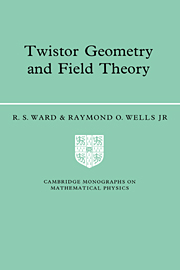8 - Self-dual gauge fields
from Part III - The Penrose transform
Published online by Cambridge University Press: 08 October 2009
Summary
This chapter deals with the twistor construction of solutions of the anti-self-dual Yang–Mills equations *Fab = — Fab on Euclidean fourspace E4. Of course, the construction applies equally well to the selfduality equations *Fab = Fab, simply by switching orientation on E4, or (equivalently) by using dual twistors instead of twistors. And it also applies to the Lorentzian signature versions *Fab = ±iFab, by analytic continuation. But, as we saw in Chapter 5, the most important applications of (anti)-self-dual gauge fields (namely instantons and magnetic poles) have involved the Euclidean version.
The basic theorem relates anti-self-dual gauge fields to holomorphic vector bundles over projective twistor space. This correspondence is described in detail in §8.1. It enables one to obtain, in principle at least, all solutions of the semi-linear system of first order partial differential equations *Fab = —Fab.
At the end of this section is a discussion of massless fields defined on an anti-self-dual gauge field background, combining the description of such gauge fields in terms of vector bundles over twistor space with the cohomological description of massless fields given in Chapter 7.
One way of constructing holomorphic vector bundles is to extend vector bundles of lower rank. For example, extending a line bundle by another line bundle gives a vector bundle of rank two.
- Type
- Chapter
- Information
- Twistor Geometry and Field Theory , pp. 371 - 432Publisher: Cambridge University PressPrint publication year: 1990



